Vinegarhill
Whilst doing research into Janefield Cemetery, we came across many of the show people’s final resting place. The people of Vinegarhill were a major part of Camlachie’s history .
Photos © copyright-The Herald and Times Group
The piece of land known as Vinegarhill plays an important part in the history and development of Camlachie. There may also be some debate as to how the area became known as Vinegarhill. It is possibly named after the Battle of Vinegar Hill which took place on 21st June 1798 in County Wexford, when General Gerard Lake (1744-1808) routed the Wexford Rebels in a clash between Protestants and Catholics in Ireland. Another explanation for the name Vinegarhill, and slightly more mundane, may relate to a firm called D. King & Co., who carried out vinegar production at Camlachie from 1837 to 1860.
Events elsewhere in Glasgow gave Vinegarhill its best known identity. In the 1870’s the city fathers decided the carnival and circus that appeared during the Glasgow Fair opposite the High Court on Saltmarket and Glasgow Green, would have to be relocated, and moved them to Crownpoint, and then on to Vinegarhill at Camlachie. The site at Crownpoint was short lived for the showpeople, and they had to move from Rowchester Street when the Corporation decided to build a tram depot there in 1893.
Vinegarhill became the prime site in Glasgow for the annual carnival, and the showpeople were to have along association with Camlachie. The carnival or ‘shows’ were located on the north side of Gallowgate, on both the east and west sides of Vinegarhill Street. The 1896 map of Camlachie shows a switchback railway on the ground to the east side of Vinegarhill Street, but by 1912 two switchback railways existed within the walled carnival to the west of Vinegarhill.
The postal address for East Vinegarhill was 917 Gallowgate and examination of the 1928-30 voter’s roll reveals that there were 190 adults eligible to vote, and this gives us some idea of how important the site had become to the showpeople. In 1930 East Vinegarhill was acquired by the Corporation, who opened up the piece of ground as a children’s playground and football pitch. The walled carnival grounds at West Vinegarhill, postal address 845 Gallowgate, were owned by the Green family, and following the closure of East Vinegarhill in 1930, only selected families made the move into Green’s property.
The attractions and events at Vinegarhill have been many and varied, and it is interesting to look at some contemporary newspaper articles over the years;
The Detective – 16th July 1885 :
‘Among The Shows At Vinegarhill’
‘The ‘shows’ with their yards of flapping canvas, still brave the breeze. Doubtless our social progress has condemned them to an obscure grave, but they die hard. The showman is not easily killed, his canvas always a fascinating influence over the juvenile portion of the community, and the pictures that adorn the exterior of the booths are sufficiently tempting to induce the youths to deliver up his penny at the door. The degenerate condition into which the ‘Fair’, as represented at Vinegar Hill has gradually fallen bespeaks at no distant date to collapse. The good old days that made Glasgow Fair famous are gone, and in their place we have a collection of starved hares and canaries, smooth faced giants, mysterious looking females, colossal alligators, and diminuitive men and women. Leaving historic Trongate, and skirting along Gallowgate, dodging in turn tram-cars and old women with apple stalls who implore me to invest, I reach the Fair ground.
What a noise! the yelling, howling, swearing, laughing, thieving and devilry. What a combination of brass bands, steam whistles and organs! Here every human contrivance is put into operation in order to draw the hard-earned copper from the pockets from the artizan. Everything under the sun, from ‘Birds of Paradise’ to ‘Tamed Rats’, all are crowded together in a small square for the benefit of holiday makers. Trumpet speaking men proclaim the excellence of their particular show, about which ‘there is no deception’. Zulus dressed in their native costume execute war dances on the platform, and invite visitors to step inside.
Tragedians, arrayed in all their glories of tin helmets and spangled jackets, with wooden swords, loudly assert that they will play ‘Hamlet in five long acts’. Fairies, in satin and muslim bid defiance to the time honoured custom of keeping behind the curtain, and strut on the outside stage as alligators, that is if the representations on the canvas are correct, and a sudden impulse toview the aforesaid snakes seizes me. But my desire to enter is nipped in the bud, a sheet of paper the writing on which announces the show is ‘full’, so I have to pass on.
Every show is not doing such a roaring trade as the ‘snakes’, and seduced by the oratory of a cockney I elbow my way through a motley crowd of acrobats, clowns, equestrians and ponies, to the door where an old lady collars my penny, after which performance, I am allowed to enter the ‘Grand Circus’. The audience is not large and mostly composed of youths who are tumbling head over heels, crawling below the seats, and indulging in other acrobatic tricks with a view to qualifying themselves for real circus work in after life. As the last shout is given ‘Begin’, and the performers take up their place in the ring. A piebald pony is introduced, and a youth who attempts to wipe paint off with his bonnet is very promptly cuffed by the clown. The old circus tricks are repeated, and in ten minutes we are again in the open air. Allured by the tones of an exacrably played fiddle, I enter a palace of delight called a ‘penny gaff’.
But the place is abominably dirty, and the odour of the company and of the lurgan twist they are smoking is powerful, so very powerful that it frightens me and I bolt.
A sparring booth is the next place worthy of notice. Professors of the ‘noble h’art’ are haranguing the crowd, and invite all and sundry to step in and have a ‘go’. I am not at all inclined to pay twopence for the privilege of having my nose double its ordinary size, so again I pass on. ‘A reg’lar beauty’ shouts a bleary-eyed, dissipated looking fellow, ‘weighs twenty six stone’. I gazed at the enormous size of the woman depicted on the canvas, and then the very small proportions of the caravan, until I am lost in wonder, as to whether the woman holds the house, or the house the woman. It is no use disputing the ‘beauty’ of the woman as tastes differ, and I leave the proprietor, though he doesn’t look like one, endeavouring to entice open-mouthed urchins inside the tent. During the next few minutes I am in the midst of the ‘hares’, ‘snakes’, ‘wonders workers’, and ‘jugglers’.
Insinuating owners of ghost shows try to wheedle me within their web, but I am obdurate. Sometimes a pretty, occasionally and ugly, face makes a fierce dart at me from a shooting saloon, and endeavours to thrust a gun into my hands; now a lazy Italian, with his ice-cream, seizes me by the arm and whispers his price into my ear. But I am not to be wheedled, and passing rapidly over the smaller fry, I reach a booth clean and tidy in its outward appearance, where ‘Alonzo the Brave’ is the chief attraction. I enter the temple of drama, passing in my ascent, villains, robbers and heroes. There is a large audience composed of every conceivable grade, from the swell with his eye-glass and spats, down to the dirty faced urchin who wipes his nose with the cuff of his ragged jacket. Here is a youth indulging in his first dissipation of summer drinks, while there is another one who is cramming cakes of gingerbread down what appears to be a bottomless pit. And here is a factory girl, who has come to have a good ‘pen’orth’ of the drama, while there is the gammin all eyes and ears for the commencement. ‘The band will play the last ‘toon on’h outside’ cries the first robber, ‘and when we go h’inside to begin’. The musicians strike up ‘God save the Queen’ and the actors make their way through the audience and pass through the stage door. The band is seated, there are two or three preliminary flourishes on their part, and then the curtain is rung up.
I do not wait the consummation of the drama and amid the murmurs from the pit I see the door. The rain is falling heavily and the crowds are gradually melting. Therefore, and as I have had enough of the shows for one season, let us jump into this tram-car bound westward, and seek the cosy circle around the fireside.’
The Glaswegian- 15th July 1886
There is the usual display of tinsel and canvas, high flies and discordant music, at Vinegar Hill this year. There are the usual crowds of pleasure-seeking lads and lassies, and to all appearances this year’s show is much the same as on previous occasions. One new feature, however fails to be noticed, and it is the securing of one of the tents for religious services on Sunday. This is as it should be. These showmen are for the most part strangers in our midst and unaquainted with our manners. It is only our duty to see that some form of worship is provided for them, and it is to be hoped this system will not be reserved to Glasgow or to the present holiday season.’
Lord George Sanger’s Circus and Menagerie
‘Vinegarhill to the Glasgow man is a name to conjure with. At certain seasons of the year in the old days the holiday spirit could not have been laid aside without a visit to the crowded pitch with its blaring merry-go-rounds and thrilling ghost illusion. Now with the trend of the city westward many of the showfolk have shifted camp, and the vacant space at Camlachie is not the Vinegarhill that it used to be. On Saturday however, there was a revival of the old stir. Round the gateway, the flags were once more flung to the breeze, the crowds gathered from all parts of the city, crossed the threshold. It was a splendid testimony to the value of a name, after an absence of six years Lord George Sanger, the man who divides with Barnum the title of the world’s greatest showman, had returned to Glasgow with his hippodrome and menagerie. At the evening performances the attendance in the tent could not have been short of 10,000, and despite the multiplicity of tastes represented, this vast audience remained interested throughout the long programme. The programme winds up again with a grim representation of the struggle in South Africa. Among other incidents dealt with is a cavalry bivouac on the way to the relief of Mafeking. The concluding item is a grand fight, in which pom-poms are brought into action, a Boer waggon is burned, and the British come out on top. As a side show the Menagerie is also a big attraction.’
The Era, Saturday 8th September 1900
Showmen at Fairs
1870s: Glasgow (Vinegar Hill): John Swallow (lessee): circus .
1870s: Glasgow (Vinegar Hill): John Day’s Crystal Palace Menagerie (Miss Lily Day as the “Lion Queen.
1870s: Glasgow (Vinegar Hill): John Mander’s Waxwork show
1870s: Glasgow (Vinegar Hill): Professor Anderton’s Illusions
1870s: Glasgow (Vinegar Hill): Crecraft’s Novelty Shows
1870s: Glasgow (Vinegar Hill): Willie Campbell: the Glasgow Giant
1870s: Glasgow (Vinegar Hill): Randall Williams: Ghost Show
1870s: Glasgow (Vinegar Hill): W. Swallow: Big Boat
1870s: Glasgow (Watson St): White: Steam Roundabout
1870s: Glasgow (Watson St): Symon’s Menagerie
1870s G. Biddall’s Ghost Show
1870s: Glasgow (High S): Collins: Theatre of Varieties
1870s: Glasgow (High St): W. Palmer’s performing seals
1870s: Glasgow (High St): Harry Wright: Boxing Show
1870s: Glasgow (High St): Joe McDonald: Boxing show
1896: Glasgow Christmas Fair: Lord Geo. Sangers Circus & Menagerie
1896: Glasgow Christmas Fair: Bostock & Wombell’s Menagerie
1896: Glasgow Christmas Fair: Reader’s Menagerie
1896: Glasgow Christmas Fair: Codona’s Ghost Show
1896: Glasgow Christmas Fair: McIndo’es Ghost Show and Gondolas
1896: Glasgow Christmas Fair: Birchall’s Ghost Show
1896: Glasgow Christmas Fair: George Green: Venetian Gondola and Tunnel Railway; John Green: Steam Bicycles and Steam Swings
1896: Glasgow Christmas Fair: J. White: Tunnel Railway
1896: Glasgow Christmas Fair: Walter Wilmot: Three-abreast Jumpers
1896: Glasgow Christmas Fair: Swallow: Four-abreast Jumpers
I would like to thank Pauline Gashinski for this information
http://members.shaw.ca/pauline777/TravellersUK.html
Prominent Showman
Death of Mr. John McIntyre
By the death at the age of fifty-three, of Mr. John McIntyre, 132 Janefield Street, the East End has lost one of its best known personalities.
Mr. John McIntyre, who died in Stobhill Hospital, was extremely well known as an amusement caterer, not only in the East End, but in many other districts.
Along with Mr.D.Taylor he was responsible for the running of a carnival on Fleshers Haugh, Glasgow Green, a few years ago and previous to that he staged another carnival at Queens Park.
For many years Mr. McIntyre was an official of the Scottish Section of the Showman’s Guild and at the time of his death held the office of vice-president
Under the name of The Major, Mr. McIntyre was a weekly contributor to The World Fair, the showman’s weekly newspaper. An enthusiastic member of the Royal Order of Ancient Buffaloes he was responsible for the founding of one branch appropriately named the Jovial Travellers Lodge.
Memorial Service
The respect in which Mr. McIntyre was held was shown when a memorial service was held in Gallowgate Parish Church last week by the Rev. James Sutherland, who is honorary chaplain of the Showman’s Guild . Attending the service were brethren of various R.O.A.B. lodges, members of the Showman’s Guild Committee and many other friends.
His three sons, John, now in the R.A.F, George, Royal Engineers, and Charles, who was recently discharged from the Royal Artillery, attended the service.
Following the service the funeral took place at Janefield Cemetery where the hearse was met at the gates by a company of several hundred people. The service at the graveside was also conducted by the Rev. Mr. Sutherland. Brother Kissel, of the R.O.A.B. also conducted a short service during which each member dropped an ivy leaf into the grave.
Amongst those present were members of various Corporation departments. The grave was heaped with beautiful wreaths and among other tokens of sympathy were a marble Bible on a slab from the show people of Possilpark, a marble shield from the Showman’s Guild, and seven flower vases from Showland.
Letters of sympathy have been received by Mrs. McIntyre from Ex Lord Provost Sir. Patrick Dollan, and many members of the Town Council and Corporation Departments.
Taken from Eastern Standard March 7th 1942.
Showman’s Football
The Annual match between Glasgow Thistle (showmen) and Hearts of Midlothian (showmen) was played last Friday at Helenslea Park the ground of Parkhead F.C. A good attendance was present.
Players to catch the eye were Thomas Slater. Joe White. and J. Ratcliff. The game resulted in a draw of no goals.
The replay for the championship takes place to-day (Friday)
Taken from Eastern Standard 1927
The German Gypsy Encampment at Vinegar Hill, Glasgow
The above photo was published in 1906 with the following caption;
“THE GERMAN GYPSY ENCAMPMENT AT VINEGAR HILL, GLASGOW.
These people, who have caused the Home Office some vexation of spirit, have stirred up a great deal of local interest, and their camp has been visited by thousands of Glasgow people.”
A Gypsy Invasion
Not a little stir has been caused in these parts by the arrival from Hamburg of several parties of German gipsies, to the number of about 80 in all. The police Kept them moving, but they nevertheless made themselves obnoxious by their bold begging and even forcible seizure of what they wanted at lonely houses. As it was reported that 5000 in all were coming, the public became alarmed, and some newspaper correspondents suggested that among them were German spies. They evade the provisions of the Aliens Act by coming in batches of less than 20 in one steamer, so someone has coached them. Lord Balfour of Burleigh asked questions regarding them in the House of Lords on April 30th. Lord Tweedmouth, in replying for the Government, tried to minimise the matter, and said that it was understood that the gipsies were on their way to Italy. Most of them have now settles on the vacant show ground at Vinegar Hill, in the east end of Glasgow, and have been making money by aerobatic performances of a sort. Last Sunday four of their babies were christened in the German Church in Woodlands Road, when a crowd collected sufficient to fill the church several times over. Despite Lord Tweedmouth’s assurances, people are not satisfied, and feel there is something yet to be discovered as to the cause and purpose of this sudden invasion. Loud complaints are also being made at these foreigners being allowed to beg and grab in a way that would not be tolerated for a moment if Scotsmen acted thus.
1906
His Amusements Are Fair Ground Tradition
Mr. John Cadona well known amusement caterer and one of two surviving sons of the late Mr. William Cadona, founder of Cadona’s Amusements, died at his home at 216 Smithycroft Road Riddrie, on Monday morning. He was 62 years of age.
Mr. Cadona had been in the amusement business all his life. At an early age he assisted his father in the running of fairs and carnivals in which he was an acrobat of no mean repute.
Those were the days when his father’s “Ghost illusions” were at the height of their popularity, and when the roundabouts were pulled by little ponies.
Later he made extensive tours of Scotland and the north of England with his own amusement unit which included the famous Wall of Death, the roundabouts, and many other entertainments which have come to be associated with the tradition of the fair ground.
For many years during the Fair Holidays he held the annual Carnival at Bellahouston,, the present site of the White City Greyhound Racing Company, and his Christmas Carnivals at the Kelvin Hall Glasgow, and the Waverley Market, Edinburgh, will be remembered by many.
Mr. Cadona lived in Riddrie where he had his garage and repair shop, for about six years.
Mr. Cadona is survived by his widow and a family of six, three sons and three daughters, all of whom will carry on the business.
Mr Nathaniel Cadona who lives in Paisley, is now the only survivor of the late Mr William Cadona Senior.
Taken from the Eastern Standard 27th November 1948
The Fair Fifty Years Ago
Memories of Vinegar Hill’s Departed Glory
When Sanger Had The Greatest Glasgow Circus
Mr. Carstairs of 126 Landressy Street Bridgeton, the writer of these very interesting reminiscences of the old Glasgow Fair, is a prominent member and official of the Old Men’s Club at Glasgow Green.
The Fair. The very name rouses sleeping memories, and the older folk have no hesitation in saying “The Fairs no what it used to be”. Perhaps it is well but it is interesting to think of the changes in the past fifty years.
Nowhere have bigger changes taken place than at Vinegar Hill, the East End’s famous showground. Vinegar Hill of today gives little or no indication of the attractions which made it a Mecca of amusement-seekers half a century ago.
To-day there is only drabness where fifty years ago there were music and laughter and glamour. The hill retains not even a shadow of its former glory- except in the memories of those who frequented it in the good old days.
Fifty years ago it was a pleasure ground of many features. There was H. Holden, Old Adelphi Theatre, a permanent building run by Mr. David Prince Miller. A little further on stood Clarks famous ghost illusion-in those days a household name throughout the length and breadth of Scotland.
John Manders moving wax-work was always strongly patronised. Crowds flocked to see the moving figures of King Solomon and his court as they took part on the historical incident concerning the two women who laid claim to the same child.
Professor Anderton’s flying bird cage created a great sensation, while another attraction was John Swallow’s popular Circus, at which many got free entertainment by watching the outside parade of a full equestrian company and ring horses. Mr. John Swallow, by the way was lessee of Vinegar Hill for many years.
There was something to suit every taste in the grounds. Creecraft’s novelty shows. W.Swallow’s elaborate big boat, Willie Campbell, the Glasgow giant all attracted their quota of the crowds that thronged to Vinegar Hill.
Randall William’s full ghost illusion company on parade to the latest music provided by the grand orchestral organ was another memorable event.
Another show ground that attracted many of the Fair holiday makers was at Watson Street near Glasgow Cross. Among the more or less regular features here were Symon’s Belleview menagerie, Whit’s steam roundabouts, and George Biddall’s ghost pavilion another famous thriller.
About this time Sanger’s great fete and gala was held on the old Shawfield running ground. Sanger on this occasion had three circus rings running simultaneously, and presented what was probably the finest equestrian company ever seen in Glasgow.
Each day by way of advertising the show, a magnificent procession paraded the streets. The band accommodated in a resplendent carriage, led the way, followed by a number of artistically arranged tableaux the most impressive of which was that representing Britannia and the lion.
The fact that a live monarch of the forest was used added to the thrill of the occasion. The procession included a magnificent tableaux carriage drawn by forty superb horses, driven by the famous “King of Reins”. Three brass bands took part in the procession, and it was not surprising that the streets were always lined to witness the spectacle.
It was generally conceded that this was one of the greatest shows ever seen in Glasgow, and its success amply repaid Sanger for his enterprise.
Yet another showground was situated in High Street, where Collins Theatre of Varieties, with a full dramatic company, was the top of the bill attraction.
A herd of elephants, Camels and dromedaries was a centre of interest; while W. Palmer’s performing seals were one of the sensations of the year, their wonderful performance being literally “the talk of the town”.
The followers of the noble art were also well catered for, as Harry Wright and his troupe of scientific boxers were always ready and willing to take on all comers, while the boxing pavilion of Joe McDonald, a renowned Scottish pugilist, was the scene of many a full blooded battle.
No on serious consideration, the Fairs no what it used to be.
Taken from the Eastern Standard 13 July 1929
Vinegarhill Celebration
King And Queen The Happy Couple
Mrs. Kelly’s Recipe For Married Life
For one brief spell on Monday Vinegarhill, East End show ground, rang with the laughter of gay festivities. The show people were celebrating the golden wedding of the King and Queen of vinegarhill, Mr. And Mrs. John Kelly.
Everyone in the caravan colony took part in the celebrations, and Mrs. Kelly made the food for the feast herself and carried out arrangements for a dinner at night.
Mr.and Mrs. Kelly however, celebrated their wedding anniversary simply over a cup of tea in their own caravan.
Mr. Kelly, seventy three years of age ,has been in the show business since he was nine years old.
Mrs. Kelly , is sixty nine years of age, and both have lived in caravans since they were sixteen. We married young , and have been happy every day of our married life, Mrs. Kelly said.
The old woman has her own recipe for a happy marriage.” Give one another a good hiding now and again then make up quickly, That will keep you right”
Time marches quickly in the show business. The Kelly’s caravan stands on the rails of the old scenic railway which thrilled millions of visitors at Vinegarhill in bygone days.
Mrs. Kelly’s grandson drives the rocket railway, hair raising highlight of the Empire Exhibition amusement park.
Taken from the Eastern Standard 1938
FAMOUS GALLOWGATE HALL DOOMED
But “Ring” May Be Completely Renovated
Old-Time “Geggie,” Pioneer Cinema, And Boxing Mecca
A closing order has been issued for The Ring, Gallowgate, the famous boxing hall. No more contests are to be staged there, and the building may be pulled down within a few months if the order is carried through.
There is regret amongst many East End boxing fans that one of their favourite halls is to be shut down, for The Ring has the rare reputation of always providing a good “bill”.
A Historic Hall
The Ring has had an interesting history, closely associated with the fortunes of the Green family, the famous amusement caterers. As a boxing booth it was opened in December 1929, but for some thirty years before that it was about the foremost amusement hall in the East End.
Before the people of Glasgow went “doon the watter” or visited Blackpool or the Isle of Man at the Fair, The Ring was part of Carnival Ground, controlled by the Greens. The Ring was then a “blood” or “geggie” – in other words, it was a variety house – supplying old fashioned dramatic thrillers, with a number of variety turns.
Those who appeared in it included names familiar to the older generation – Mrs Ferguson (who starred in “Rob Roy”), Johnnie O’Connor, Burke (a great tragedian of his day), and Mavis Curley and Bob Hill, who also appeared in Green’s building at Bridgeton Cross.
Some years before the War there arose the cinematograph, and, quick to see the possibilities of this new invention, Green’s changed The Ring into a “cine,” and actually made it the second picture house in Scotland. After a number of years The Ring again changed to variety.
This in turn died out, and for some years the building lay empty. In 1929, however, Mr James McOnie, who had been with the Green family for many years and who was manager at the Stadium, suggested that the building could be made suitable for boxing. The proposal was carried out, and Mr McOnie took over control.
During its term as a boxing venue, many top-line boxers have appeared there, including Steve McCall, Jim Maharg, Tommy Spiers, Jack Kilrain, Jim Winters and
Bobbie Shields (heavyweight champion of Scotland, who trained at The Ring and was managed by Mr McOnie). Ted (“Kid”) Lewis, former lightweight champion, refereed a fight there two years ago. One of the most fervent supporters of The Ring was Sir Harry Lauder, who was actually present the last night boxing was staged there.
Mr McOnie is one of the personalities of Scottish boxing, but he has also had other interests, notably in the early days of Socialism, when he was an active member of the Catholic Socialist Party. He was an intimate friend of the late Mr Wheatley.
“Ring” May Be Renovated
He still holds out hopes that The Ring may reopen for boxing, as he informed a Standard representative this week that plans were being considered to make radical alterations to the building to bring it more into line with the best modern boxing halls.
Glasgow Eastern Standard
Saturday, November 11, 1933
A Geggie–Originally a travelling side-show or playlet. Hence ‘penny geggie’ and thereafter ‘shut yer geggie!’ (be quiet!)
The Entrance to Vinegar Hill
Gypsy Smith Is Coming For Meetings In Miami
Captain Gypsy Smith will reach the city the last of next week, and will begin a series of revival meetings on Sunday March21 in the First Baptist church.Cain Smith came to this country last summer for a short stay and Dr. J. F. Carson of Brooklyn, N.Y. were so favorably impressed with him that they arranged for him to make a return visit to Brooklyn .
Captain Smith is now in Toronto, Canada, in a great meeting. As the boys say, he has the goods and knows how to deliver them.Gypsy Pat Smith as he is familiarly known was born 25 years ago of gypsy parents in a gypsy tent on Vinegar Hill the famous show ground for many long years the Mecca for patrons of Glasgow Fair.
He is of the purest Romany stock. He was converted at 16 and began preaching as an evangelist at the age of 17.
After his conversion he did not enter into the methods of making a living after the manner of his people, and finally his father told him that he was not making money and that he would either have to give up his religion or leave home.
He went away and began his career as an evangelist. Some time afterwards he went back to the caravan of the Romanies and led his mother to Christ and afterward his father.Later when he was conducting an evangelist meeting in Glasgow, his two sisters were led by him to accept Christ.
At the break out of the war young Smith had many engagements ahead of evangelistic meetings and had planned a nine month campaign in America and Canada. He cancelled all of his engagements and joined the colors as a private.He entered the service august 5th 1914 the day after war was declared, and was on the firing line on the day the armistice was signed.
He was offered a commission but refused it as he did not know anything about military tactics.
He was soon promoted to the rank for service on the field.
He went to France in 1916, went through several minor engagements and finally went over the top on July 1st at the battle of the Somme, with the famous Tyneside Scottish Brigade.
His battalion suffered frightfully in this engagement, 28 officers and 714 men being killed outright, only 114 men and 5 officers came back and all were wounded.He was 10 months in the hospital and underwent many operations. The use of his arm was restored and he went back to the firing line, where he stayed and fought during the last seven months of the war.
On being released from the army Captain Smith returned to evangelistic work. He has closed a notable mission in Sunderland, England, where at the last service 3,000 people crowded the building and hundreds were turned away, His mission in Belfast was one of the greatest religious movements ever held in the city.
Taken from The Miami News 1920
In 1916 on July 1 at 7:30 in the morning 1000’s upon 1000’s of British and French troops rose out of their trenches that stretched 14 miles across the grassy plains that had become a “no man’s land” across France in the Great War, and began a slow advance against what they thought would be a few straggling German resisters and an assured and easy victory. Instead, the chiefly volunteer army was met with a cataclysmic barrage of firepower that they were powerless against, having marched across a flat land with nowhere to escape their doom. This event, the Battle of Somme, still holds the record for the most casualties in a single combat day, over 58,000, almost 20,000 of whom lost their lives. Those that were wounded were left to either die in “no man’s land” or scrape themselves inch by inch back to the protection of their home trenches. Those who could not retreat often died slowly and painfully over the next three days, right where they lay. One of the wounded survivors, Captain Pat Smith, was able to make his way back and after several months in the army hospital recovered from his wartime injuries. Pat Smith’s journey to Somme and the worldwide fame that followed him from there began many years before in a gypsy tent in Scotland.
David Prince Miller
In Court yesterday there was considered an application by David Prince Miller for a theatrical license in connection with a building at Vinegarhill, Camlachie, to be called The Adelphi Theatre. The license applied for was limited to four months.
Several of the justices expressed their opinion that a cheap theatre in the district of Camlachie would influence detrimentally the youth of the neighborhood. In answer to a question from the bench, it was stated that the lowest sum to be charged for admission war threepence.
After considerable discussion, the license was granted by a majority of six to three votes.
The Scotsman Dec 3rd 1872
Swing boat colorized by T McCann
An Alligator At Large
Early yesterday morning those sleeping in an adjoining tent at Sangers Circus at Vinegar Hill Glasgow, had a somewhat unpleasant visitor, It appears that an alligator had escaped through the smashing of one of the panes of thick glass through which he is observed by visitors to the circus.
The aperture made was about three feet square, Large enough to allow him to crawl through and drop to the ground. He then crept across the yard, a distance of 60 feet and the first thing that seems to have attracted his notice was one of the sleeping tents. This he entered and seized a boy named William Scott, one of the employees by the right foot. The shrieks of the lad awakened those in the vicinity and attempts were made to frighten the animal off.
At length a man named Reuben Wilson took hold of the creature by one of the hind feet and hauled him back to his confines. The injury to the boy Scott is not serious, and consists only of a few cuts near the ankle. During the commotion one of the serpents also escaped, and was caught crawling up one of the sleeping caravans
From The Aberdeen Evening Express 12 June 1891
When Vinegar Hill Was At Its Zenith
By Old Harry
During the past quarter of a century the Gallowgate east of John Street (Millerston Street) has not changed much from what we knew in the seventies or eighties, except for the frontage of the old Vinegar Hill Showground. Many old houses are still standing, but the old showground is open to the street without gate or stile.
In the sixties, I think the fair was still held in what is now Jocelyn Square, a better title than jail square of old time. The booths and stalls then had to find fresh fields and pastures new. This they found in Crownpoint and Vinegar Hill. With the building of tramway stables in David Street the ground at Crownpoint was lost and the entire fair housed at Vinegar Hill.
This was a piece of land on which there had been at one time a foundry possibly David Napier’s.
Down one side flowed the Camlachie Burn, A wretched looking little stream. In winter time it was a sea of mud, and in the summer a Sahara of dust. The atmosphere was odorous with the smell of oil, tars, curriers grease, resin and other things being prepared or manufactured.
The fairground was arranged in some sort of plan; the big shows formed a half circle at the back of the ground. There were two entrances of a kind at the east and west ends, with an inside circle between these of smaller booths and stalls for the sale of sweets, hot peas, lemonade, toys ete, on either side of a makeshift street.
Inside this circle were most of the merry go rounds, hobby horses and velocipedes.
The big shows were pretty good and well worth the small charge of admission. Why, I once saw the entire play of The Silver King in twenty minutes done in the best style, a la Wilson Barrett.
The Ghost Show was excruciatingly funny. This was Clark’s adaption of Peppers Ghost by means of plate glass. It was the shows that Barrie mentions in Auld Licht Idylls.
Trowhead went to the exhibition, but from his seat he could see behind the scenes, and saw more than he intended. He laughed when the rest laughed, but he never saw where the fun came in.
Then there were the shooting ranges, much affected by the young men of the period, where you might have the pleasure of having your rifle loaded by your mother’s star girl. Needless to say, the guns were muzzle loaders.
Then there were booths showing feats of jugglery, acrobacy, pugilism and wrestling. The Brummagen Chicken would wrestle the world.
Standing aloof from the rest of the fair was a permanent erection that is , it was of wood not canvas. This was The Adelphi Theatre, which was run by Mrs David Miller, widow of the former famous Glasgow actor manager.
Swallows Circus also a wooden erection, stood at the opposite end of the ground from the Adelphi. Here was good equestrian entertainment from a penny to four pence, with the clowns very latest seventeenth century jokes thrown in.
There was the inevitable fat woman, the swings, the Waterloo Fly – an A regular beauty, shouts a bleary eyed dissipated looking fellow, Weights twenty six stone. I gaze at the enormous size of the woman depicted on the canvas, and then at the very small proportions of the caravan, until I am lost in wonder as to whether the woman holds the house or the house holds the woman.
It is no use disputing the beauty of the woman’s taste differ, and I leave the proprietor though he doesn’t look like one, endeavouring to entice open mouthed urchins inside the tent.
During the next few minutes I am in the mist of hares, snakes, wonder workers, and jugglers. Insinuating owners of ghost shows try to wheedle me within their web, but I obdurate. Sometimes a pretty, occasionally an ugly face makes a fierce dart at me from a shooting saloon, and endeavours to thrust a gun into my hands, now a lazy Italian, with his ice cream, seizes me by the arm and whispers his price in my ear. But I am not to be wheedled and passing rapidly over the smaller fry I reach a booth clean and tidy in its outward appearance. Where Alonzo the Brave is the chief attraction.
I enter the temple of drama, passing in my ascent, villains, robbers and heroes. There is a large audience of every conceivable grade, from the swell of his eye glass and spats, down to the dirty faced urchin who wipes his nose with the cuff of his rugged jacket. Here is a youth indulging in his first dissipation of summer drinks, while there is another who is cramming cakes of gingerbread down what appears to be a bottomless pit .And here is a factory girl who has come to have a good pen` orth of the drama, while there is a gamin all eyes and ears for the commencement.
The band will play the last toon on the outside, cries the robber, and then we go inside to begin. The musicians strike up God Save the Queen and the actors make their way through the audience and pass through the stage door. The band is seated, there are two or three preliminary flushes on their part, and then the curtain is rung up.
I do not wait the consummation of the drama and amid the murmurs from the pit I see the door.
The rain is falling heavily and the crowds are gradually melting. Therefore, and as I have had enough of the shows for one season, let us jump into this tram car bound westward, and seek the cosy circle round the fireside.
Taken from The Glasgow Eastern Standard
25th June 1936
David Prince Miller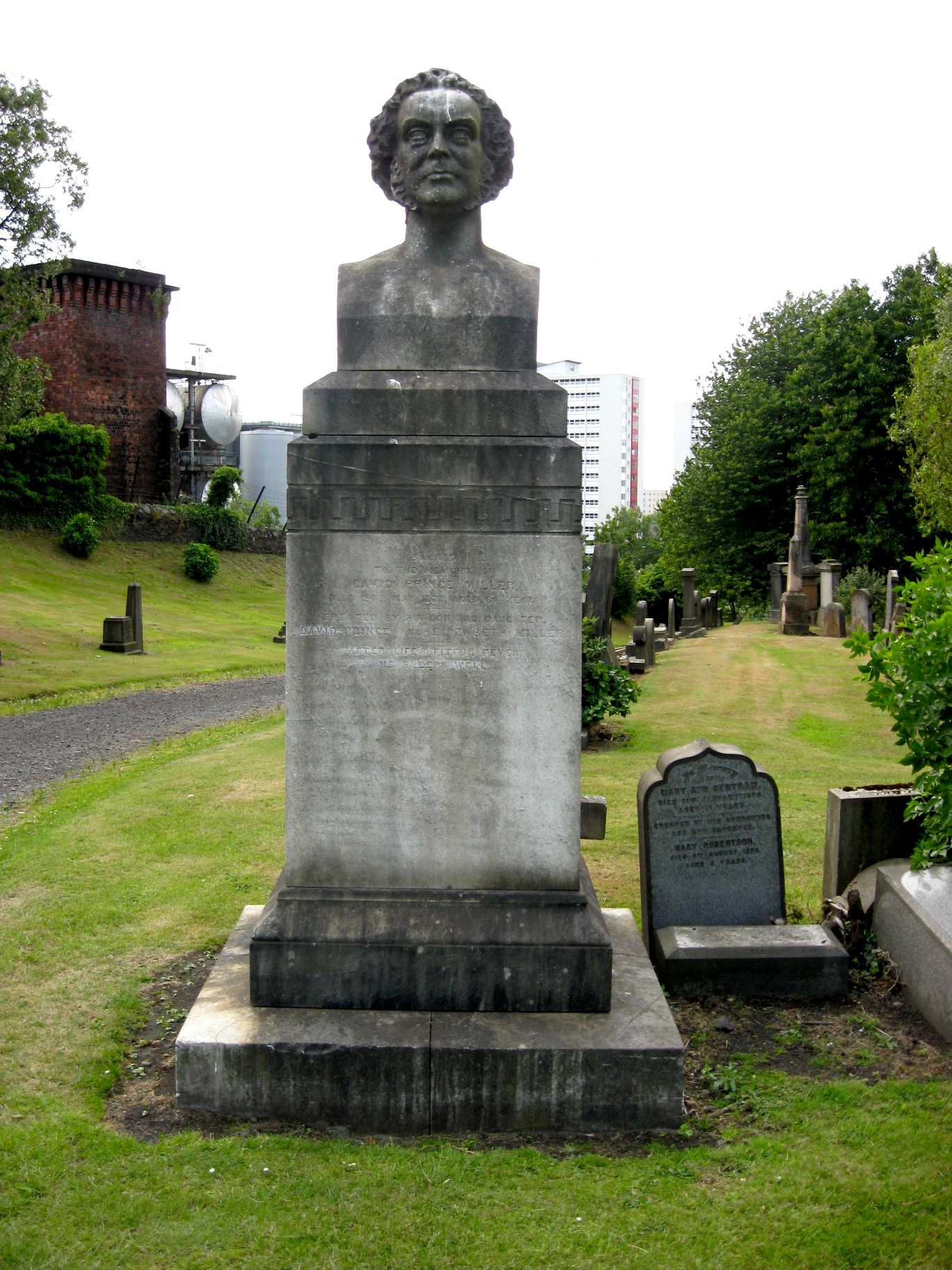
This is the grave stone of David Prince Miller It can be found at Glasgow necropolis. the insciption on the stone says, David Prince Miller, Died 24th May 1878 aged 64 years, erected by his son and daughter David Prince and Elizabeth Miller. After lifes fitful fever he sleeps well.
From Glasgow Green to Vinegar hill
By Old Harry
On the beginning these reminiscence’s I fancy a good start could be made with the last days of the shows in Glasgow Green and Jail Square about 1860 or 70.
Glasgow Green was very different then and now. There were no enclosures except the iron railings round the Greens boundaries and along the river banks. At Glasgow fair and the New Year holiday time. The shows appeared at the Jail Square entrance to the Green and extended from the pavement to far up the Green. Swallows circus was the great attraction in these days. Other circuses were Jeannette’s, Manley’s, and Cadona’s and among the attractions were Menders Wild Beast Show and Wombell’s Menagerie with the lion Wallace born on the Green, and the lion tamer The Great Macoma. In my day, Wombell’s was run by the granddaughter of Wombell, Mrs Edmonds.
Ex councillor E.H Bostock of the Glasgow Zoo, is a direct descendent of the great Wombell. Mr Bostock still possesses many of the original caravans and wagons that were part of the original Wombell’s Menagerie. Another great feature was the Brothers McLeod’s Moving Waxwork. These gentlemen ultimately opened permanent exhibitions in Glasgow and Edinburgh. McLeod’s Waxwork and menagerie were quit a Glasgow institution. The Building is now occupied as a model lodging house.
The First Carnival
Colin Chisholm with his waxwork and museum of curiosities was another annual visitor at Glasgow Fair. Chisholm settled in Glasgow as an auctioneer and ran a lottery in Saltmarket, near to the railway bridge at Osborne Street. His eldest son was a partner with Green when the first Carnival was held in the old Gallowgate Barracks.
A very curious exhibition that came to Glasgow was the Camera Obscura. If anyone lost a friend in the crush of holiday makers, he was invited in and if the friend was on the Fair Ground the searcher could spot him, for a consideration of course!
Inside the building, in the middle of the floor, stood a large round table covered with white paper. The place was in semi darkness. By an arrangement of mirrors round the roof the attendant could have a reflection of any part of the ground cast on the tables. On a sunny day one could see the colours of peoples cloths and their faces came out very prominently. The Camera Obscura was run by an Edinburgh scientist, Mr Short.
A great attraction was the then new discovery of professor Pepper’s Ghost Illusion. Mr William Clark, Sen, was the first showman on the road with the ghost illusion. Mr Clark had the most expensive parade front on the road. It consisted of hand carved frames richly gilded, a mass of gold and beautiful pictures by eminent theatrical artist. Certainly it must have cost a big hatful of money. I can tell you that that front never received any blessing from me in later years, when I worked with Mr Clark. It was hung and drawn and let down with strong iron chains. The ghost illusion was worked with a very large plain glass hung at an angle and there were strong lights below the stage.
It was hard work for the actors, shouting at the top of their voices over the glass so that the audience could hear them speaking. Other ghost shows cropped up later were Biddell’s, Burrell’s, Cadona’s and Crombie’s, who bought over Clark’s Ghost Illusion. I can tell you we had also cultured and refined exhibition of beautiful oil paintings, most of them very valuable and much sought after by collectors and art dealers. The proprietor was an Italian- A man of mystery. He ran the Italian colony at the south east corner of Bell Street and High Street now occupied by Fishers Oil and Colour Stores.
This mysterious Italian could be seen every day grinding an organ through the streets of Glasgow. He was a well-dressed, middle aged little man with a grey beard and pleasant features. He looked quite out of place among the other exiles from the sunny shores of the macaroni eaters and inventors of big McCullum’s. It was rumoured all over the town that this mystery man was a political refugee and a nobleman who fled Italy to save his life. The mystery man went, as he had come, quietly. He disappeared along with his valuable collection of pictures.
Now we come to the portable theatres, better known as the Geggies. Mumfort’s old geggie still stood at the corner of Saltmarket and Greendyke Street, but it was before my time. My earlies recollection of Geggie’s on Glasgow were Sennett’s and Perry’s, or Purry as the Glasgow buddies called him. Perry had had a Geggie near the English Chapel in Greendyke Street on ground now occupied by a skin and hide market. A little further up, where the Corporation Lodgings House now stands was trainer’s Padden Ken or Lodging house and Banks McNeil’s swimming baths were on the site of Paddy’s Market.
Apropos the skin market. I may state that that business had formerly been carried on in a very large building on the banks of the Clyde beside the old weir. After the hide and skin people left, the building lay empty for a long time, then Jack Swallow opened it for the winter season as a circus, but didn’t do very well .After him Manley’s circus people had a go at it but didn’t catch on. This is where I first saw Mr Robert Ferguson of Geggie fame. Bob Ferguson was then ringmaster and business manager for Manley’s circus. Other geggie’s beside Senet’s were David Prince Millers, Glenroy’s and the Patterton’s.
At Vinegar Hill
When the powers that be abolished the shows in Glasgow Green the new show ground was Vinegar Hill and vacant ground in David Street, Whitevale, where David Street School now stands. I remember the first fair in the East End. Johnny Matthewson, the famous clown and pantomimist from the Prince of Wales Theatre (Later the Grand) and the Theatre Royal, opened a Geggie in David Street, and the Wilmot’s had a lot of merry- go- rounds and swings there too.
Matthewson and his brother Jamie were both painters to trade. They were clown and comic policemen, in the first pantomime produced at the Princess Theatre by a Mr McFadzean, who was the first lessee of the theatre. On the showground at Vinegar Hill David Prince Miller had some time previously erected the Adelphi Theatre which was winter quarters for Jack Swallow’s circus. In the beginning the transference of the shows to Vinegar Hill gave the showmen a very hard time.
The tramways were in their infancy and it was asking too much of a canny Scot to pay bus fares to Camlachie and squander the rest at The Shows. So for a year or two Vinegar Hill was no great catch as far as showmen were concerned.
After years of success, the shows at Glasgow Fair Holidays are conspicuous by their absence, gegie’s and ghost and waxworks and circuses are matters of memory. The pictures and the gramophone have put the travelling showman off the road for ever. Gone is the giant, the dwarf and the fat lady. Nothing of the splendour of the fair but a few dolly boards, swings, cock shies and hobby horse remain.
This was taken from The Glasgow Eastern Standard 1925
This story for me shows the wonders of the fair and its sad decline .
Gipsy Wedding
Picturesque Scene In A Theatre
The course of true love did not run smoothly for the bridal pair of German Gypsies at Vinegar Hill, Glasgow, on Thursday. Arrangement’s had been made for celebrating the nuptials of the fairest daughter of the encampment, Lene a sweet looking girl of 18 years and Paul Muller, a young man who some time ago forsook the block and cleaver in Stettin to follow the simple life of the Teutonic Wanderers.
Unfortunately, the swarthy visitors had reckoned without our Registrars, for on application to the German Pastor in Glasgow to officiate at the wedding, they learned for the first time that they must first fulfil the Scotch Law obligations.
As these entailed residence in our midst of three weeks it became impossible to carry out the ceremonies as were desired. What was to be done?
The bride and bridegroom were arrayed for the festive occasion, the wedding party were like wise in readiness, a large assembly of the public who had paid for admission were clamouring to witness the unusual spectacle of a Romany wedding.
The alter was the stage of the Whitevale Theatre a commodious building forming part of the Carnival attractions provided for the East Enders by Mr Geo. Green. Hither the crowds had flocked all afternoon, and at four o’clock, the hour at which the ceremony was announced to take place, the theatre contained a representative company.
Camlachie residents were in the majority, but there was a good sprinkling of well-dressed woman who had evidently been attracted by curiosity. After a spell of waiting, the tedium was relieved by the appearance of the orchestra, who were soon rattling out the strains of Stop Yer Tickling Jock.
Several musical turns by local artist followed, after which the stage manager amidst applause announced that the Gypsy wedding would now take place. Appearances did not belie the statement, for next minute the curtain rose and revealed a background of the gaily attired nomads.
The central figure was of course the bride. Lene was picturesquely attired in a white dress, over which were several sashes of brilliant hue, while on her head she wore the Romany headgear of a bride, a flowing veil of many colours. She also had white satin shoes, and a pretty bouquet of flowers.
Shoe was by two bridesmaids, brilliantly attired. The bride groom, named Paul Muller, was also attired in Romany costume, which included several quaint sashes, while his bowler hat was bedecked with red ribbon. The entire encampment turned out, and their garb was a revelation to the public. The king and Queen were present, the former bearing a banner of red.
After the gypsies had given a remarkable exhibition of dancing and sang several songs in German, Pastor Geyer addressed the company. He stated that of all the strange jobs he had ever had during his 23 years’ experience as a pastor in Glasgow that was undoubtedly the strangest.
He explained that the gypsies were all well-meaning, law abiding people, and were anxious to amuse the public for a living. The couple they were all interested in had requested him to perform the marriage ceremony, but the pastor explained the Scottish Law, and stated that another twenty days would have to elapse before it could be performed. He counselled the people of Glasgow to treat the gypsies kindly, as they were Christians, and had sought him for baptism for their children.
What they had just seen on the stage by the gypsies was their own Romany rites, which gave them an idea of how these people married their own kith and kin. The pastor added that he had been satisfied from the birth certificates shown that that the people were Germans, and were travelling about the country. The most of them spoke Hungarian a language in which he had been able to converse with them, while others spoke a little Italian and French, which showed that they had been traveling about the country most of their lives. The pastor was warmly applauded as he left the stage.
Thereafter the gypsies gave another exhibition of dancing, but several hitches occurred before the orchestra had selected suitable music. Irish jig time appeared to meet their taste, and it was surprising , to say the least, when the heaviest of the gypsies, the King who weighs between 18 and 20 stones skipped about the stage in his grotesque garb, apparently as light as a fairy.
The bride and bridegroom were among the most accomplished of the company, the former singing a somewhat plaintive song , while the latter gave an exhibition of what is known on the music hall boards as Russian dancing. They were evidently delighted with the cordiality of their reception, and expressed their intention of appearing nightly at the theatre..
Taken from The Daily Express Mon 30 April 1906
A new book by Jean Stirling is on sale now and is well worth a read,,
The Origin of Glasgow Fair
Jocelyn, Bishop of Glasgow, was a friend of William The Lion, and from that monarch he obtained authority, somewhere between 1175 and 1178, to have a burgh at Glasgow with all the rights and privileges of a royal burgh, and further Charter in 1190 empowered him to hold a Fair for eight days – from the octaves of the apostles Peter and Paul – commencing on July 7th.
This was confirmed by a later charter in 1211 ordering the King’s peace to be kept during this time, under a fine of 180 cows for manslaughter.
Such was the origin of Glasgow Fair which has continued down to the present day, although its original purpose of a general market has been lost. Ordinary trade was suspended and all was centred on the Fair, and in addition to business and devotion for the Fair commemorated the consecration of the Cathedral on the octave or eight days after the feast of St Peter and St Paul games and sports were held and all sorts of amusements provided.
The Fair was first held at the “Wyndheid”, where Rotten Row enters the High Street, then at the Water Port at the foot of the Stockwell, and then for many years at Glasgow Green; finally, in 1871, the merry-go-rounds and “shows” were transferred to Vinegar Hill where they dragged out a dead-and-alive existence. The humours of the Fair have formed the subject of many poems and ballads, particularly in the 18th and early 19th centuries.
Kirkintilloch Herald, 1953



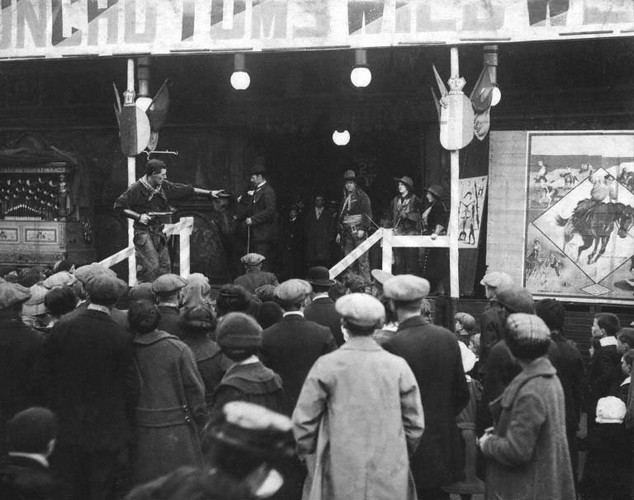
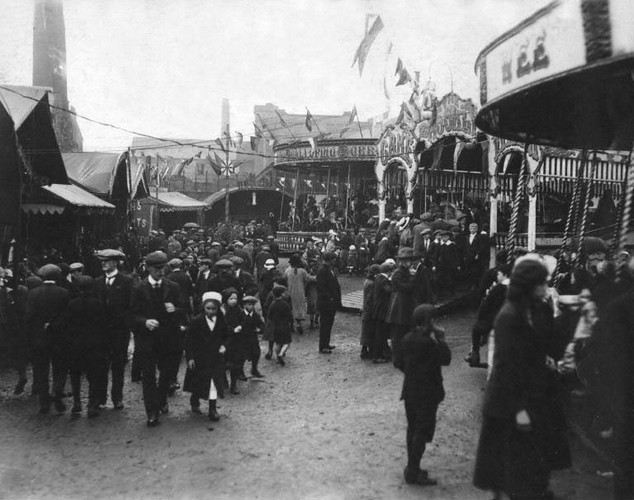

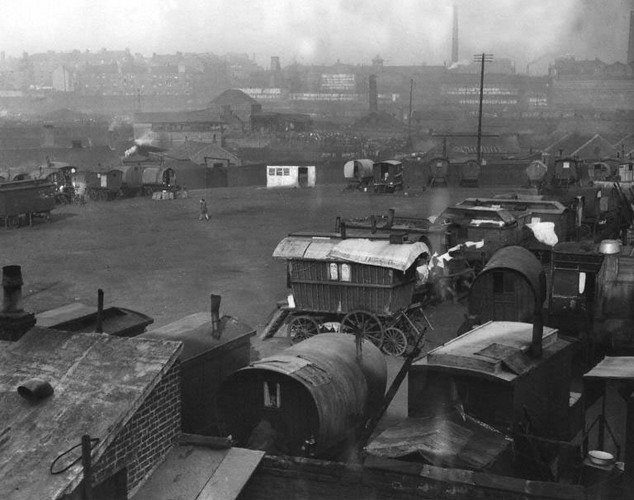
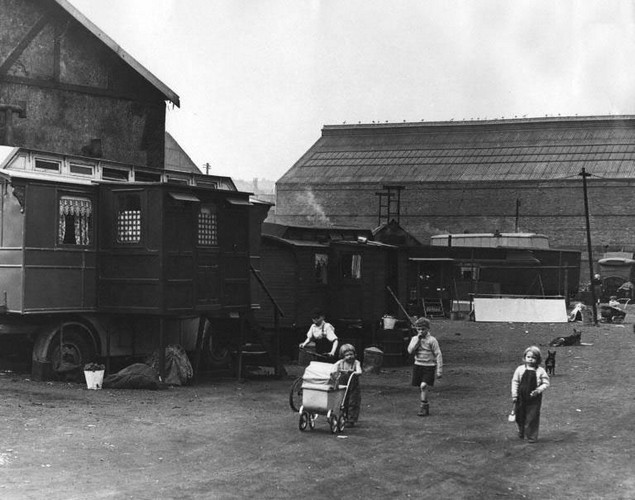
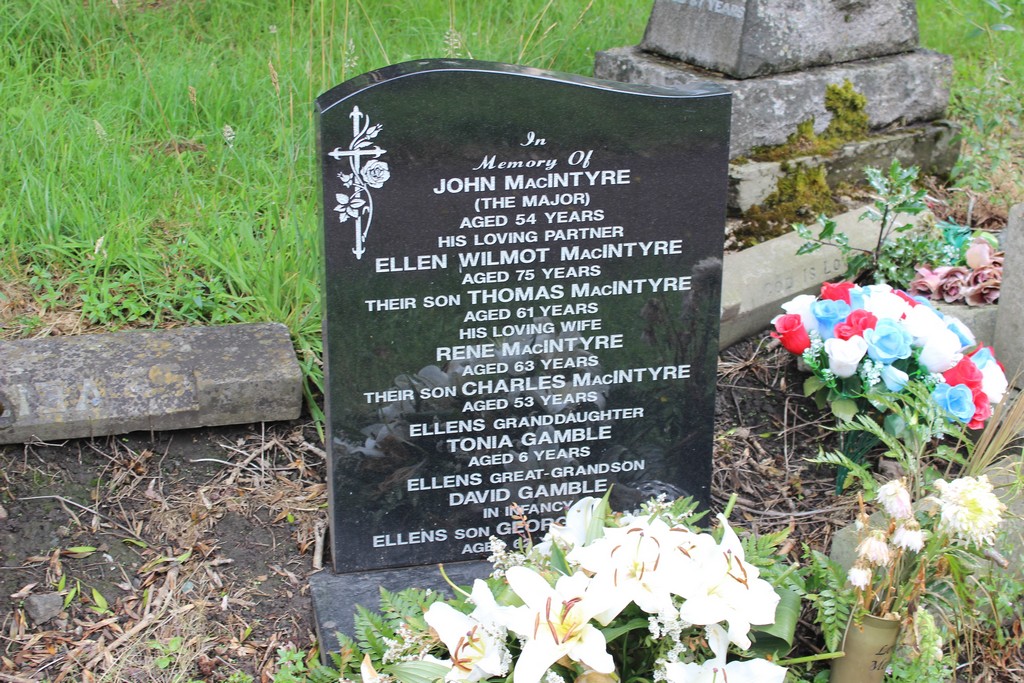



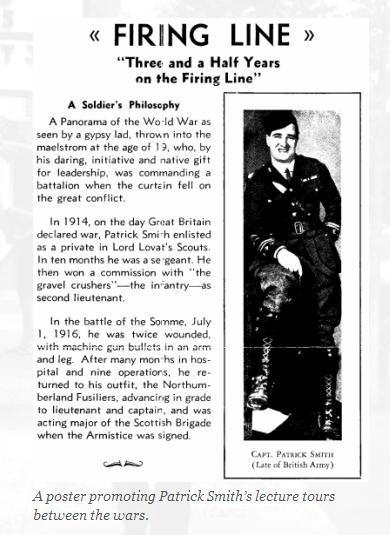

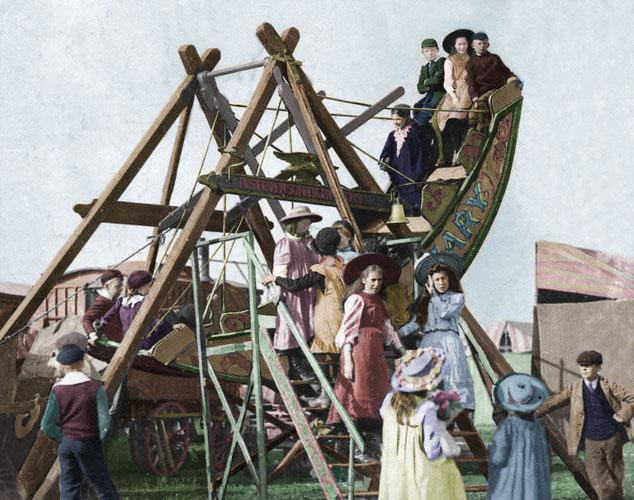
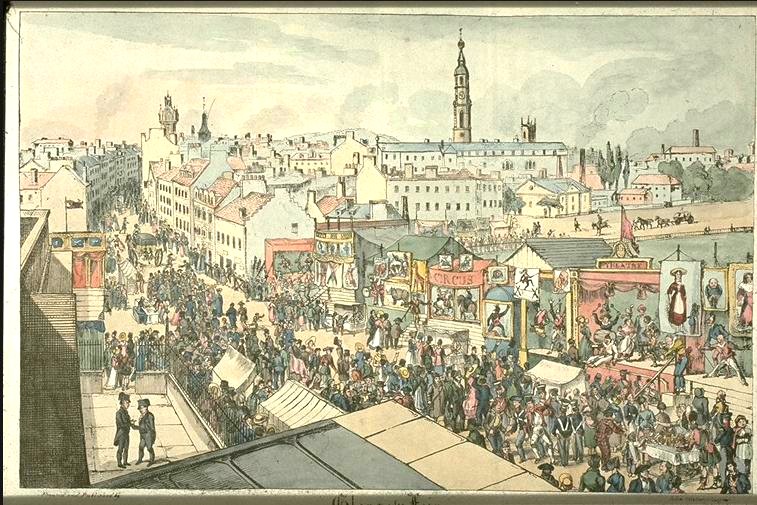

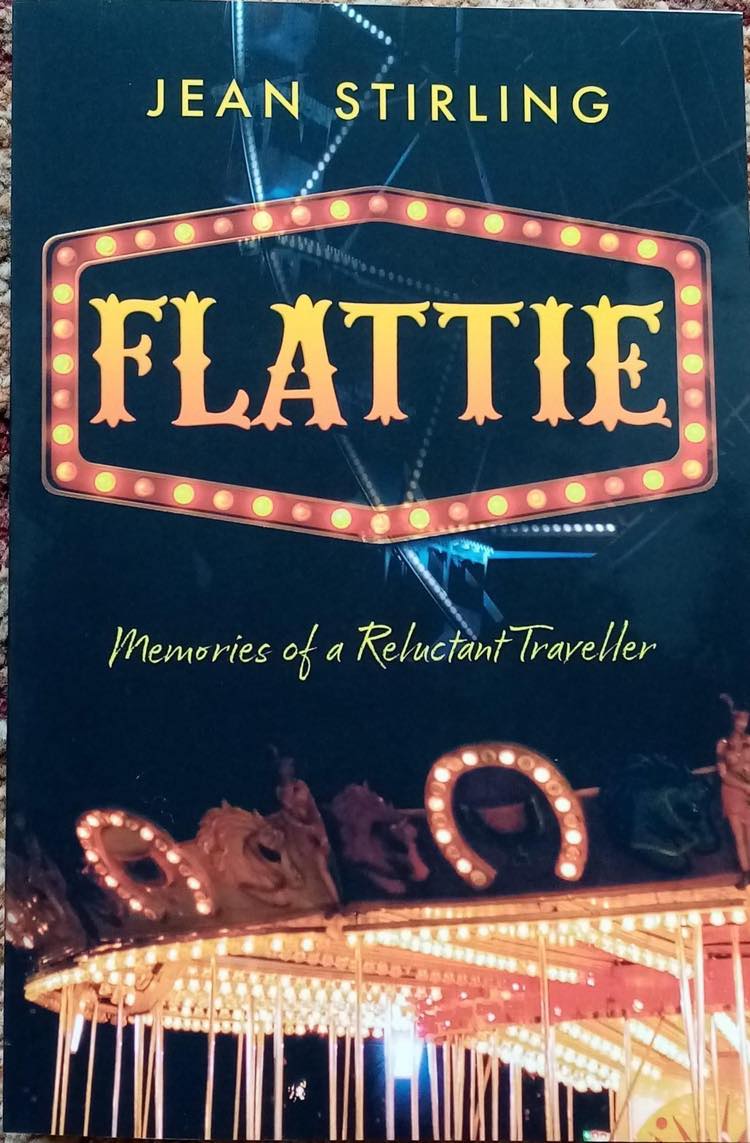
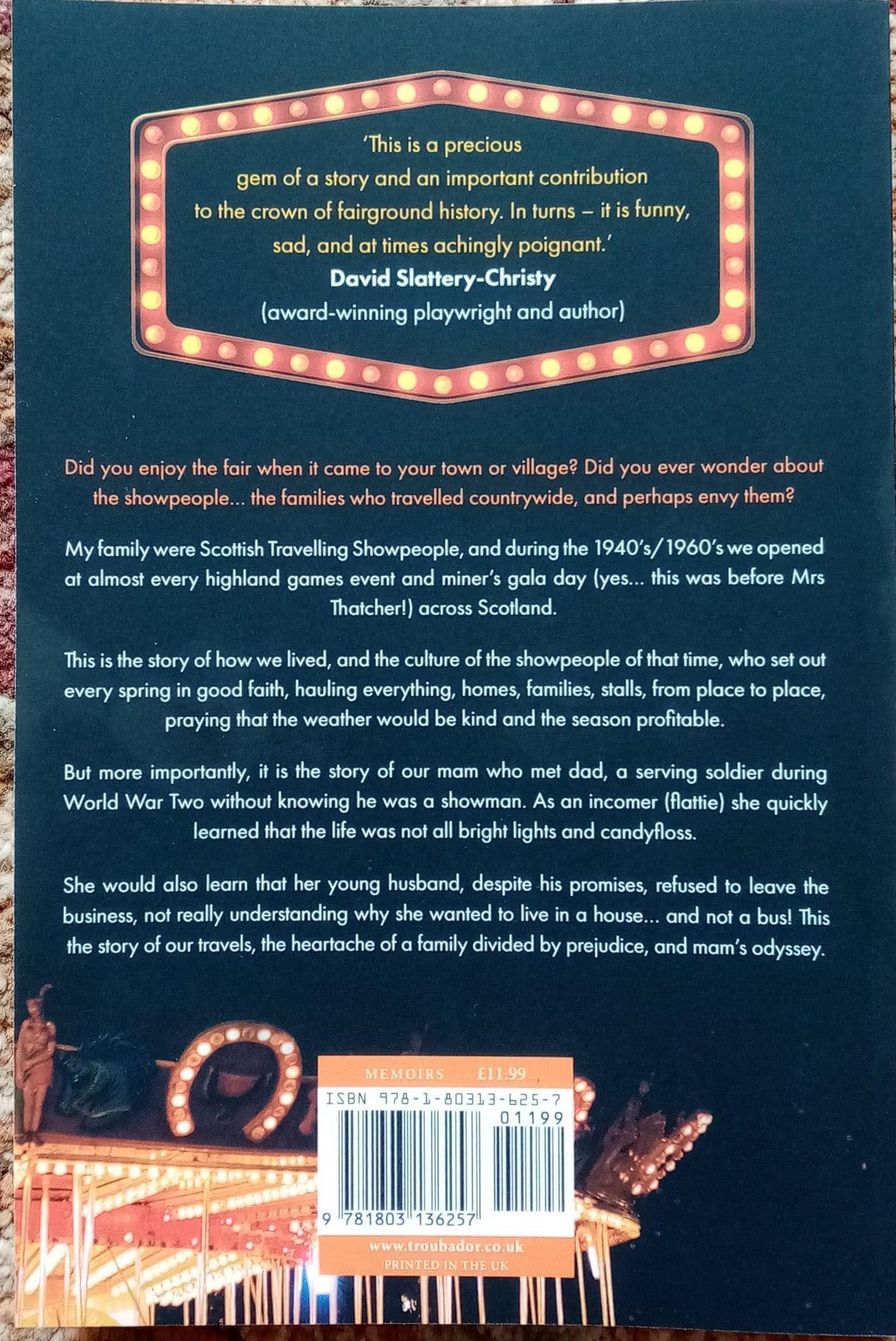
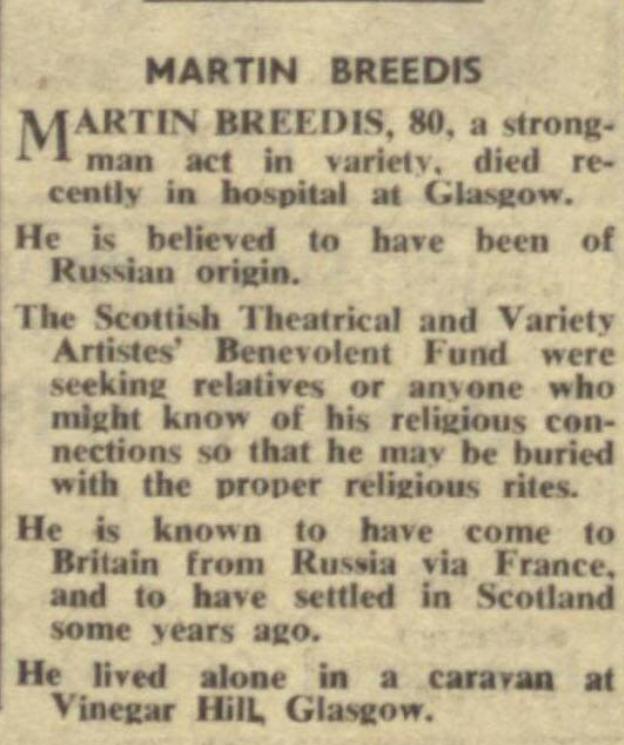
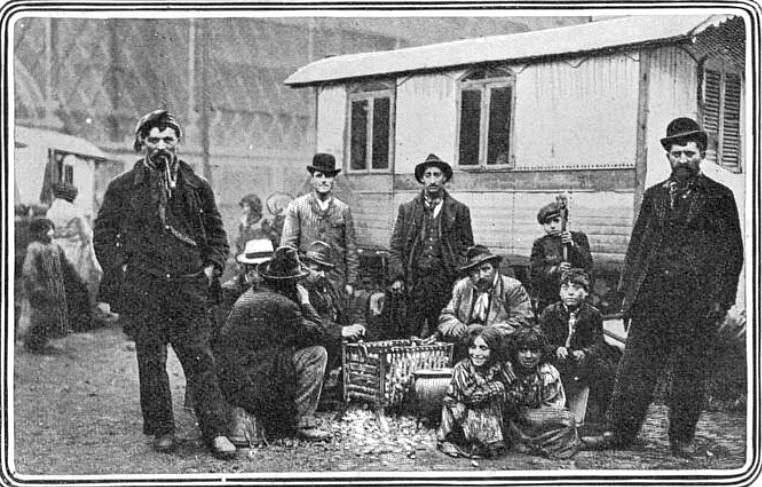
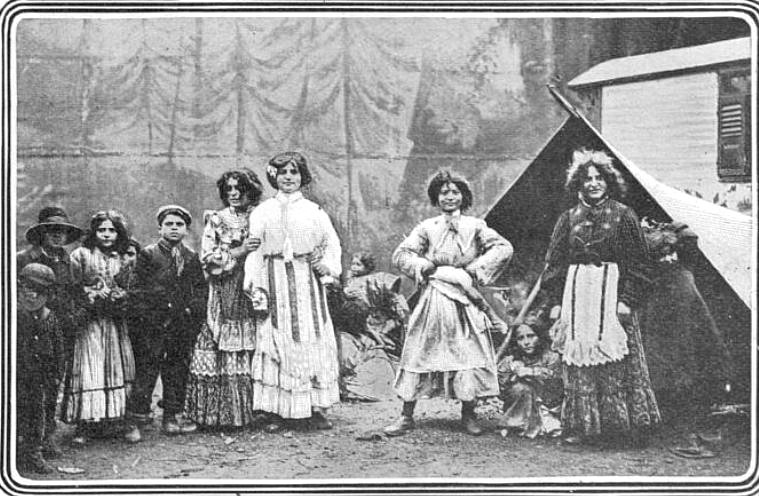


I’m glad someone took the time to put all this information together it’s been a joy to read it all and get to know the beginnings of it all
Has anyone got info on the fell family 1890/1905
Frederick fell showman at vinegar hill
Cornealous fell wax museum at trongate
Hi
Does anyone have any info on The Fell family.
Frederick fell showman and organ grinder around 1890-1905
His father Cornealous Fell who had the waxworks on Trongate.
I’m trying to piece some family info together
Does anyone on the site have any further information on the Act named as Bob Hill and Mavis Curley. I think these may have been stage names and would very much appreciate any help or possible further leads to help track down further information.
Long shot but If anyone has any info on the Carter family that lived in Vinegar Hill in the early 1900s I’d be interested. James Carter & Margaret Carter (Campbell) had their daughter Alice there in 1903. James was an Amusements Caterer from Consett, County Durham in England. His dad was Charlie Carter. James & Margaret’s son James had his child with Grace Restrick, Also called Alice, in 1916. The family moved around & also were through in East Kilbride showgrounds in 1921.
Who remembers Barney’s I know all these family names from the 70’s when i worked for my uncles Billy & Julie Green
Remember Barney coming to Saltcoats every summer we opened there got all my swag from him and when I opened my Giant card dart stall the first in Britain he would show me all the new swag first because of the amount I was using
I am Albert Cannon’s sister, and I am researching my family tree using family search. If anyone has any information I would be grateful, I am trying to build up the Cadona’s tree, with all the relationships and marriages with the other families. Anyone can start an account on Family search at no cost, and help build a tree which is shared, only information about people who are deceased is visible. I would appreciate dates of births and deaths and marriages, together with places if known along with names and relationships. Once this information is entered there is a way of adding memories on, as photos or typing stories which can then be shared.
I was in Albert’s class at Camlachie Primary between 1955-1959,one of the Smith family was in our class as well, Leslie perhaps.
Sorry I don’t remember much more,I always hoped to come across a class photograph from those years but no luck.
Hi James Leslie Smith was my big brother sadly passed away 3 years ago I have a Camlachie school photo with him man Albert Cannon in it
Hello Rachelle
My name is Marlene Graham Alexander we are related through our mothers your Mum (my auntie Maggie ) and my mum Lina. Blockley
I used to baby sit you,
Albert and I was good pals, we all parted once the ground at vinegarhill was taken over by the council
your MUM was a very kind hearted lovely woman she used help my auntie polly and her brother Albert blockley in their bingo at the kelvin hall
Give my best regards to Albert
Hi Rachellle am Violet Smith what is family search please
Hello,
Does anybody have information on Charles and Mary Ann Smith (nee Daly). I know they were showpeople at Vinegarhill and had several children. Mary Ann would be my mother’s great aunt. Any info would be wonderful/pointers to archives or photos!
Best
Hi Ester Charlie an Maryann are my Great Grandparents
I’m keen to discover any information on a Patrick McArdle of Tylefield Street. Mattie Ann/Annie McGuigan (1895-1975), who’s family originate from the Calmachie/Vinegarhill area.
Thanks
my father samuel cairns was born in tylefield st in 1920.
Below is the Web Site and podcast from artist Mitch Miller Tales Fae The East
Pingback: Mitch Miller - 02 - Tales fae the East
My Grannie came from showfolk.im sure they had family surname Gay,, She was Annie Lawson, had brother Joe Lawson, sister Bella Jeanie, my Grannie stayed in Germiston, her married name was McGinty. I can remember my mums cousin Charlie Lawson he had a daughter Rosemarie, they stayed in show ground in Darnick Street. Not seen Rosemarie for over 20yrs, the last time I saw any of the Lawsons ,was at my grannies funeral must be over 30 yrs ago, it 2as in St Rochs Chapel Garngad. My Mum was Rose McGinty,married to James Wallace from Garngad.
There’s a Joe Lawson on the showman’s yard next to Shettleston Juniors.
My dad George Merrick was born in Camachie in 1918. His dad, also George, is shown on the 1911 census as living with the Testo family (Alexander Testo) in Vinegar Hill. He married Agnes Anderson the same year. Anyone any memories of the family? I never get to know my dad as he died in 1976 when I was young. Any info appreciated.
My granddad was born in 1914, on the Gallowgate. His name was Harry Merrick, son of Harry Merrick. He had 9 brothers and sisters. Possibly a cousin of your dad’s? Also related to the Testos ☺️
I think your grandfather George may be the brother of my grandmother Harriet born in 1890 and Winifred who married a Testo and were also show people. However, I have a record of a George living at Vinegar Hill in 1908 with my great grandfather William Merrick plus siblings William, Harry, Harriet and Winifred. William Merrick was from St Luke’s, London born 1847 if he was the father.
Anyone heard of my relatives who were Amusement Caterers: William/Wullie Brown, Lizzie Brown (nee Smith) Sarah Brown (nee Rose)?
Uncle Wullie’s address in 1933 was c/o Graham’s Shows, Gallowgate – any idea where that was?
My mum (Carolina Winters) was born at Vinegar HIll in 1923. Her cousin was Pauline, known as Polly and she married Horatio Spencer, they went on to tour the country with their ride. Hoping the names mean something to someone x
Hello Frances, Polly Spencer was my aunt, mum (Nora)’s sister. Unfortunately Aunt Polly passed away last New year, aged 94.
Horatio and Polly travelled with rides across the whole of the UK, then settled in Dunoon, where they owned a restaurant (the blue shutters). They moved back to Glasgow to care for my grandmother, where my aunt Polly lived until last year.
My uncle Horatio passed away many years ago.
A very popular couple, they had a very fulfilled life, lots of enquiries and well-wishers for them.
☺
My grannies was friends with a Becky smith she had a van in vinerger hill in the fifties we used to go to her caravan my mum and my auntie used to travel with the whites and caddonnas they did the roll a penny stall . I know a few yrs ago the cadonnas owned a snooker club in bailiston don’t know if it’s still open a lot of them went to camlachie school and came to the guides and brownies in st Thomas’s church
There is a Cadona’s amusement park in Aberdeen. My grandmother, May McEvoy, knew the Cadonas. She married a Johnnie O’Neill whom she met at Vinegar Hill in about 1914 or 15.
Hi my mam’s Auntie Elizabeth Burnside married a Charles O’Neil. I was wondering if it the same family all I really know they were showmen
Becky Smith was my aunt died quite a few years ago I was born in the showground my relatives are the whites and the cadonas my aunt Janie is still alive and lives in garthamlock
This is my Granny
My Granny was Becky Smith and related to the cadonnas
My great grandmother was Phillis Hanley, I’m trying to find out more if anyone can help?
My Granda and his family lived in Vinegarhill,
Michael Kelly, born 1927.
:-)
My Great/Great/Grandad John Adens & Great/Great/Grandmother Agnes Adens were living at 7 Vinegar Hill in the 1881 Census. Does anyone have any history and/or details of this area.
20 years earlier in 1861 my GGG grandparents (Young) lived in Vinegar Hill. He worked in a local chemical works and later as a cotton weaver. She worked in the local cotton industry. My GG grandfather (David Young) and GG grandmother (Agnes Gray) were married in 1864 from their respective addresses at 10 and 8 Vinegar Hill. He worked in the local iron foundry (iron roller) and she was a steam loom cotton weaver. I think that was pretty much the norm in this area. Ordinary men and women working in the industrial complex that grew up on the banks of the Camlachie Burn in the 19th century.
hi Tony, I came across your comment while searching about the Adens – we appear to have the same ancestors. Living at 7 vinegar Hill was John Adens and wife. Agnes Adens was their daughter – also at the address was the son Robert Adens. I have a lot more info and family tree online let me know if you are interested. John Adens is my 3 great great great grandfather.
Hi John
I’d appreciate any info on the Adens. I believe my ancestor is Sarah Adens/Edens who married Michael McGuigan.
Thanks
i was in the choir in camlacie school what happened to francky my mate
I knew Tommy Swallow very well as he attended the day centre which I ran in the church in Helenvale Street , Parkhead before he died. A proper gentleman was Tommy and I never tired of his tales of travelling to all the various fairs in Scotland. He loaned me a book once in which his family featured and I am sure he gave it back to his nephew Gilbert who lived in the Carstairs Street area where Tommy lived.
Hi looking for links to Swallow family. My great grandfather was William Wallace swallow. I am a third cousin of jonnie swallow who was married to Frances kayes
I have the self published book roundabout Britain by j swallow I’m now Looking for photographs of any swallow family to add to the tree or further info
WILLIAM WALLACE SWALLOW, born 1832 England, death 1890 Scotland, wife JANE ( O.BRIEN ), parents WILLIAM& FRANCES.
Hi my grandfather was Peter swallow Jonnys brother my dad also is Peter we live in Glasgow
Hi my grandad was called Charles Swallow from Rochdale, my great grandad and great great grandad we’re also called Charles Swallow. I don’t know if there would be any connection but I’m trying to trace my roots as I was told that we have gypsy/travellers in the family.
I read all this information ,it’s great to see this is all part of my history.
Albert Cannon is my 2nd cousin my name is Marlene Graham
My name is RoseAnn Codona nee Smith. I know and remember Maggie and Paddy. Nice to see Albert is still on this earth. Marlene Graham was my friend on Vineger Hill I always asked to look after Marlene’s cycle when she went in for her dinner. I didn’t have a cycle I am one of 9 .
Hello Roseanne,
That all seems like another lifetime ago, and I try never to forget.
Very kind of you to remember me also.
Kindest regards to you
Marlene.
Hi Marlene.
I’m Jill the youngest of the late Douglas Graham and Rosemary Testos Children.
I recognised your name if I’m not mistaken do you remember them.
Thank you
Jill
Hi Jill
I grew up with them both in my life
uncle Douglas and my dad HARRY WERE BROTHERS
I knew your sisters and brother and your mum, auntie rosemary
But by the time you came long we had all gone our separate ways I was
at
their anniversary at the busby hotel and sadly at both their respective funerals
Kindest regards
Hope you are having a good life
Your cousin Marlene.
Xx
Hi Rose Ann ,
I wonder if you were the girl who attended St Anne’s school in David. st in the late forties .
I am Cathie Kerr , Kirk at that time and was befriended by a girl from Vinagerhill .
Hi RoseAnn, my great grandfather was Lawrence Smith. Married to Mary Ann Rose. He was from Bavaria, died in Vinegarhill. Any relation?
You’re also my cousin was your dad my Uncle Harry and Auntie Lina your mum? My grandparents were Kelly they had a wagon on Vinegarhill, infact my great granny owned the original lower ground in vinegarhill. My name is Mamie my sister Sheila my mum was Polly and my dad Matt
Albert is my dad
did you stay in Whitevale st in the 1960’s and a brother called Charles ?
Albert Cannon is a 2nd cousin of mine His Mum Auntie Maggie Cannon and my Mum Lina Graham was cousins.
I wonder if he rembers
staying with us one summer at Rothesay. Kindest regards to him.
Does anyone remember my grandparents paddy and Maggie cannon and my dad Albert , also my cousin Albert kelly ?
Can anyone remember my grandparents Margaret and paddy cannon ? My dad is Albert cannon , just trying to find some ppl that knew them or my dad from vinegar hill
Does anybody remember the Hanley’s from vinegarhill
Sandra Cannon and her sister Eleanor they were related to the Cadona’s
my 2 cousins both now passed away
Hi my family are from Camlachie my grandmother was Jamesina O’Donnell I am related to the Stringers my mumused to talk about Cathy Stringer. My mum also came from there Helen Morgan two brother Tommy and Robert Devine dad Danny Morgan and mum Margaret, I remember playing with Sandra Cadona and the Gunn family
Hi my mother was born in vinegar hill in 1907 her name was Margaret Thompson her mother was jean nee smith and father james. they were circus people. I belive the circus was owned by Harry Paris. Any info would be helpful . Thankyou
My Grandad Eddie and Granny Margaret Stirling used to winter at Vinegar Hill.
I was born in 1971 and was one of the last kids around vinegar hill, my great grandparents were the lessees, there parents are mentioned above as the king and queen of vinegar hill celebrating there golden anniversary.
my family are fair ground showman our grand father was john smith born Bavaria southern Germany, he married Catherine Chittock
her father Samuel Chittock Norfolk area,.John smith had two sons Albert Laurence Smith Glasgow born ,James Smith moved south Travelled with James Chittock. my dads brothers Albert Smith visted the Glasgow area met up fellow showman and told some smiths are still travelling with fairs. Albert smith was d day vet.My aunt gave lot information for the book showman at war’ I welcome any information to add to our family tree.
My grannies had a friend who lived at vinergarhill her name was Becky smith she lived with her own family in a caravan there I was abou 10 she would have have been in her fifties she came to our house and we used to visit her caravan it would be about 1958 i think .but can’t remember much more
I’m descended from Catherine Chittock’s aunt Caroline (Finch) McPherson who was a lion tamer for a while. I didn’t know about the show biz connection until just recently. Catherine’s mother was Mary Ann Finch, Caroline’s sister and their mother was a Wombwell and connected with Wombwell’s menagerie.
Samuel Chittock Had three childen Catherine Ellen Chittock, Sarah, James . Catherine married John Smith from Bavaria. They had two sons Albert Lawrance Smith Born in Glasgow 1867 James was born 1869 they all travelled with Wombwell/ Bosstock circus Samuel Chittock was animal trainer par excellence for twenty years Albert Lawrence Smith married Sarah Ann Andrews Died in Child birth at side road Fenny Stratford she had a son Charles William Smith, Albert lawrence Smith remarried Annie Hornby From Sangars Circus, had four more Children Sophia Florence Beatrice Smith Nelly she married into The Gray Family Lilly, Albert, Jame,s who was born Marlow U S A Then the smiths stayed with James Chittock,Had his own show Performing Dogs monkey. agricuttural hall Islinton. family links the Royal Hannefords circus. most of this family buried Hanworth Cemetery Many of families are still with fairs (ggg Catherine Ellen Chittock)
Did he have a brother Lawrence.? Married to Mary Rose.
Hi, was Lawrence his brother? Both were musicians from Bavaria. Lawrence married Mary Rose. This was around 1870.
Hi..does anyone have a photo of the gatehouse at Vinegar Hill?
Hi Frederick, I went to Camlachie Primary School and knew many of the Vinegarhill children, and among them was my classmate John Henry Stirling, who may well be connected to you
John Henry Stirling is my cousin. My mother, June and his father, James Edward are brother and sister.
If you were at Camlachie with John Henry, then you probably new my youngest brother, Vernon.
I believe my family come from vinegar hill the stirlings
My pal at John st school, Elaine McLevie was related to the Wilmots on her mothers side. they had the galloping or habby horses as we called them down the Green at the fair…and she used to work down there at the candy floss stall..
My mother’s family “Cummings” lived in Van street for a while. There were 15 of them in all, 13 girls and 2 boys. (plus Mum & Dad)
They also lived in the Gallowgate when it was called “Great Eastern Road” at that part. Her birth certificate from Dec. 26th 1922 gives her address as “417 Great Eastern Road”
I went with a girl called Margaret Cadona away back in the late 50’/early 60’s. she was related to the Codona’s of Vinegarhill.
can anybody give me any info on the Cadona’s thank’s
Hi Carl, my family lived on Vinegarhill for many years. Can you tell me a little more about Margaret, maybe parents or brothers/sisters so I can try and find out some further information for you.
Thanks
William Codona
Hi Carl i was born in Hollywell street and went to CAMLACHIE school my grandparents the FEERICKS lived at DUNROBIN STREET in CAMLACHIE and their next door neighbours where ALEX AND NELLIE CODONA THEY HAD A SON ALEX AND DAUGHTERS NELLIE AND MARGARET , NELLIE LIVES NEXT TO ME IN BAILLIESTON ALEX IS IN AIRDRIE I THINK .
SADLY MARGARET PASSED AWAY LAST YEAR OF CANCER SHE LEFT 2 DAUGHTERS AND A SON , AS A CHILD I HAVE MANY MEMORIES OF MARGARET , ALL GOOD ONES SHE WAS ONE OF THE KINDEST PEOPLE I HAVE EVER KNOWN , I WAS CONTACTED BY HER FAMILY AND ASKED TO ATTEND HER FUNERAL AND WAS HONOURED TO DO SO
Hi Eddie, Alex Codona is my grandfather’s brother. Do you live next door to his daughter Nellie? I’m not in contact with her and would like to catch up. Could you get her details for me? Or I could give you mine? Tell her I am one of Johnny the inventor’s grandsons.
Best wishes
William Codona
Hello my Brother Alex McVey was the milk Man that delivered into Vinegar Hill, he would always talk about “Big Mary” in the place , all good intentions, myself I worked for Chick Cadona at Caldermill just by the Baileston Lights, i know they were from Vinegar Hill.
the major john macintyre had 4 sons and 2 daughters john george charles and thomas (my father) the girls are ivy and dora and his widow was helen nee willmot thanks thomas macintyre
Would your father have owned a juvinile galloping horse ride?
This is my home. 16 van street Parkhead, Glasgow E1. My grandparents were Stringers. My grandmother’s name was O’Donnell. Any info would be appreciated
Hi,
We haven’t had a chance to do any research yet but will get round to it soon and get back to you.
Cheers
My Dad is Harry Woods and was born in Tylefield Street, Camlachie and his mum was Jamesina O’donnell Woods, her sisters where Sally and Mary. My Dad had 11 siblings but there are only 3 still living now. My uncle Thomas Stringer Woods (Uncle Tucker) sadly passed away on Wednesday 30th July 2014 aged 74. My Dads aunty Cathy Stringer married Pat Winters but both passed away several years ago now but her daughter is a school teacher in Glasgow. If you want any further info you can contact me through my E-mail address. James Woods
In Quarryknowe St in the 50s 60s. There was a Woods family lived around number 75. I can remember 3 names Tucker, John [Wad], and Reena. I’m sure I’v seen a couple of posts on these great sites from Reena.
In 1944 my first days at school were spent at Camlachie primary, I can remember my first circle of friends was Albert Cannon,the Findlay boys who are relatives, the Smiths, if I can remember there was Raymond and Chris both about the same age as me, Errol, and Johnny Stirling, both now no longer with us, my cousin Allistair Hanley,Pheobe Stirling,and Kath King.
Just around the corner was the first cinema I was ever allowed to go to when I was still in shorts that cinema was the Scotia.
I wonder if any of my age group thinks of those days.
Albert canon is my dad ,
My dad remembers all you are talking about derrick